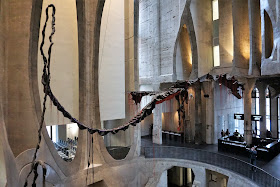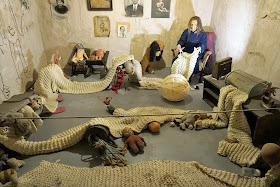Here is a problem: What does a city do with complex of ugly, abandoned grain silos strategically positioned near the fancy waterfront area, the classiest tourist area in the country?
Just down the street from that eyesore is a wonderful combination of new glass-fronted shops and an 1882 clock tower built in honor of Queen Victoria's second son, who was the first member of the Royal Family to visit South Africa.
My first thought was "Tear the old things down, of course," but obviously I don't have the vision of German gazillionaire Jochen Zeitz, who saw the abandoned silos as a perfect opportunity to create the world's largest museum dedicated to contemporary African art. Architects left the basic structure of the silos in place, but filled the top half with open spaces and bulging triangulated glass windows that look like dozens of insect eyes:
Parts of the original silos remain in place to testify of the museum's origin:
When we visited in late May, 2018, the Zeitz Museum, all 70,000 square feet of it, had only been open eight months. The opening ceremony was attended by retired Archbishop Desmond Tutu, who pretended to take a heavenly phone call from his good friend Nelson Mandela. "Yes!" Mandela supposedly told the Archbishop. "This is what we were fighting for!"
The entry/lobby has a soaring ceiling and walls with deep, irregularly round holes that make the room appear to be a cross between a hive and a cathedral, but are also reminiscent of both the grain silos the museum has co-opted and grains of corn:
A giant insect-like dragon made of rubber inner tubing is suspended in the center like a crucifix:
 |
Iimpundulu zonke ziyandilandela (trans. "All the lightning bugs are after me")
Created in 2011 by Nicholas Hlobo for the 54th Venice Biennale
See an article about it here. |
As we progressed from floor to floor, our view of the "cathedral hive" and the creature kept changing:
Ribbons drip like blood from its body:
This creature could give young children horrible nightmares:
The tail goes on forever:
There was a elevator, but the stairs were a work of art themselves and begged to be climbed, and not just for the views of the dragon from the landings. Here is a view from below looking up:
And this giant eye is the view from the top looking down:
We didn't have a lot of time to spend looking closely at each exhibit, but we did make our way through most of the museum. I'm posting some of my favorite pieces.
I'm intrigued by this raucous montage of multi-national imagery, including Fortune and Time magazine logos, the Statue of Liberty, and the American flag:
 |
| Here to Stay (2015) by Jody Paulsen |
This reclining plant man is interesting . . .
 |
| Proposed Model for Simon Tseko Nikoli by Athi-Patra Ruga |
It reminded me a lot of this piece in the Broad Museum in Los Angeles:
 |
| Michael Jackson and Bubbles (1988) by Jeff Koons |
See the resemblance?
Perhaps my favorite work in the museum is this one, made of copper and aluminum:
 |
Dissolving Continents (2017) by El Anatsui, an artist from Ghana
who is one of the most important living African artists |
Roger Ballen, an American artist who moved to South Africa has donated a large collection of his work to the Zeitz Museum. It is some of the most bizarre stuff I've ever seen. These are
The Rooms of the Ballenesque. A placard in the museum notes,
". . . the artist's interest lies in the concept of the house as a refuge from external forces that often harbours repressed emotions and experiences. He regards the house as a metaphor for the mind. . . . Ballen accompanies you into the depths of the subconscious. Set to evoke hidden memories, this space potentially serves as a gateway to the past. The stale odour and muffled whispers tap into the human psyche, enhancing discomfort. Are you prepared to be immersed and confront that which lurks beneath the surface of your own subconscious mind?"
I couldn't decide if this was an M. Knight Shyamalan movie, a very bad dream, or
The Twilight Zone:
Whew. Outta there. Let's move on to happier scenes, such as these women in combat gear riding stick horses and one real horse past vicious red dogs and vultures:
 |
| In the midst of chaos, there is opportunity (2017) by South African artist Mary Sibande |
What does it mean? I have no idea.
Okay, a little less abstract, please.
I think I can understand this powerful ink and acrylic depiction of slavery:
 |
| La Jetee [The jetty] (2010) by Julien Sinzogan of Benin |
And I can understand this pile of knitted snakes, although why someone would want to knit a snake is beyond my understanding.
 |
| Ophiophillia (2014) by Frances Goodman, a South African artist |
Wait. They aren't made of yarn after all, but of acrylic nails. I DON'T get it after all.
A curtain/waterfall of beer bottles hangs from ropes:
 |
| Qokobe (2016) by Lungiswa Gqunta, a South African artist |
According to the museum website, this artist's work
"provides commentary on the tools of segregation and oppression, using familiar and domestic objects which, when combined, become weapons. Bedsheets, beer bottles and matches recreate petrol bombs, pointing to the mobilisation of modes of resistance and agency."
I couldn't have said it
better myself.
This marble and brass sculpture is one of my favorite things in the museum:
 |
And So Be It (2014) by Daniella Mooney,
a South African artist |
Before we left we took the elevator to the rooftop sculpture garden:
Bob bought a Schweppe's Bitter Lemon in the swanky restaurant, probably the only thing on the menu we could afford:
On our way out, we stopped to appreciate the wisdom scrawled on the window. I especially like "Yes, South Africa is a country."
I loved this museum and it's contemporary vibe, but I must admit that finding a world that is a little more familiar outside was a relief:




















































